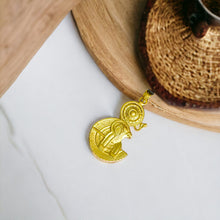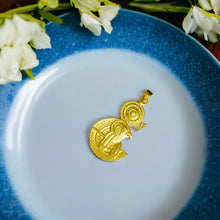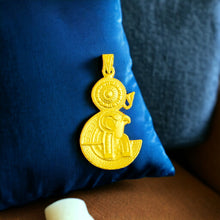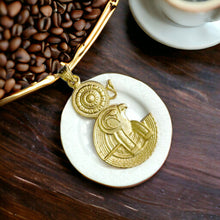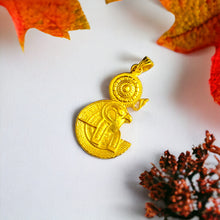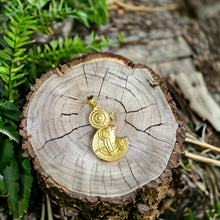
The God Gold Horus Gold Pendant Necklace is a luxurious piece of jewelry inspired by ancient Egyptian mythology. The pendant features the Eye of Horus, a symbol of protection, royal power, and good health. Horus, the falcon-headed god, was a central figure in Egyptian culture, often associated with the sky, kingship, and divine power. This necklace not only showcases exquisite craftsmanship but also carries the rich legacy of ancient Egyptian symbolism, making it both a fashionable and meaningful accessory.
- History: Ancient Egyptian deity symbolizing kingship and protection.
- Spiritually: Represents power, sovereignty, and divine protection.
- Talisman: Worn for spiritual guidance and strength.
- Handmade: Crafted with care and attention to detail.
- Healing: Believed to bring mental clarity and spiritual balance.
- Material Gold and Brass: Combines luxury (gold) with durability (brass).
- Symbolism: Horus symbolizes the sky, sun, and moon, embodying divine rule.
- How to Wear: Fits any chain up to 5mm, ideal for personal style and layering.
History Side For Those Who Are Interested
Horus is one of the most significant and revered deities in ancient Egyptian mythology. His importance spans across various periods of Egyptian history, symbolizing kingship, protection, and the celestial sky. The mythology surrounding Horus is complex, with different interpretations and attributes emerging over millennia. Here is a detailed account of the history and significance of Horus in ancient Egyptian religion:
The worship of Horus dates back to the pre-dynastic period in Egypt, around 3100 BCE, where he was initially venerated as a sky god. Horus is often depicted as a falcon, or as a man with a falcon's head, symbolizing his connection to the sky and his role as a protector. His eyes were believed to represent the sun and the moon, emphasizing his control over the heavens.
One of the most well-known myths involving Horus is the Osiris myth, which became central to his identity. According to this myth, Horus was the son of Osiris, the god of the afterlife, and Isis, the goddess of magic and motherhood. Osiris was murdered by his brother Seth, who wanted to usurp the throne. Isis, using her magical abilities, resurrected Osiris long enough to conceive a son, Horus.
Horus was raised in secrecy to protect him from Seth. Upon reaching adulthood, Horus sought to avenge his father's death and reclaim the throne. This led to a series of epic battles between Horus and Seth, symbolizing the struggle between order and chaos. Eventually, Horus emerged victorious and established himself as the rightful ruler, reinforcing the divine right of the pharaohs, who were considered his earthly embodiments.
The most iconic image of Horus is the Eye of Horus, also known as the Wedjat eye. This symbol, derived from the myth where Horus loses and subsequently regains his eye in the battle against Seth, represents protection, healing, and restoration. The Eye of Horus became a powerful amulet in ancient Egyptian culture, used to safeguard against evil and ensure well-being.
Horus was worshipped throughout Egypt, with major cult centers at Edfu and Nekhen (Hierakonpolis). The Temple of Edfu, dedicated to Horus, is one of the best-preserved temples in Egypt. Constructed during the Ptolemaic period between 237 and 57 BCE, it provides valuable insights into the rituals and significance of Horus worship. The temple depicts the mythical battle between Horus and Seth, illustrating Horus's triumph and his role as a divine protector.
Horus's association with kingship was profound. The pharaohs were often considered the "Living Horus," embodying his qualities of leadership, strength, and divine authority. This connection legitimized their rule and linked them directly to the gods, ensuring a stable and divine order in society. The "Horus name" was one of the five royal titulary names taken by the pharaohs, further cementing this sacred relationship.
Horus's influence extended beyond the realm of mythology into the daily lives of the ancient Egyptians. His symbols, particularly the Eye of Horus, remained prevalent in amulets, jewelry, and artwork. Horus's narrative of struggle and victory resonated deeply with the Egyptian worldview, emphasizing themes of justice, protection, and the triumph of good over evil.
In summary, Horus is a multifaceted deity whose mythology and worship played a crucial role in ancient Egyptian religion and society. From his early depiction as a sky god to his central role in the Osiris myth and his enduring symbolism in kingship and protection, Horus remains a pivotal figure in understanding the spiritual and cultural landscape of ancient Egypt.













